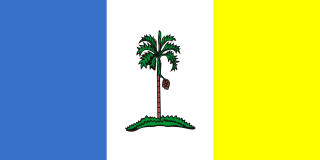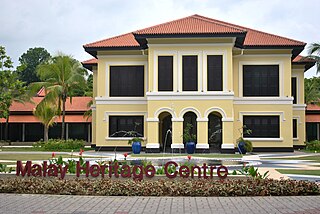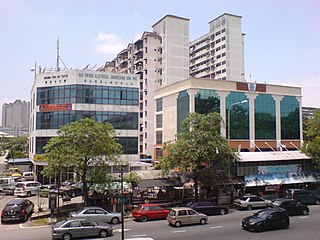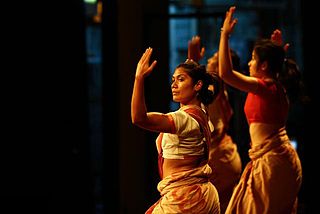
Penang is a Malaysian state located on the northwest coast of Peninsular Malaysia, by the Malacca Strait. It has two parts: Penang Island, where the capital city, George Town, is located, and Seberang Perai on the Malay Peninsula. These two halves are physically connected by the Penang Bridge and the Second Penang Bridge. The state shares borders with Kedah to the north and east, and Perak to the south.

George Town is the capital of the Malaysian state of Penang and the core city of the George Town Conurbation, Malaysia's second largest metropolitan area with a population of 2.84 million and the second highest contributor to the country's GDP. The city proper covers an area of 306 km2 (118 sq mi) and was home to a population of 794,313 as of 2020.

Kedah, also known by its honorific Darul Aman and historically as Queda, is a state of Malaysia, located in the northwestern part of Peninsular Malaysia. The state covers a total area of over 9,000 km2, and it consists of the mainland and the Langkawi islands. The mainland has a relatively flat terrain, which is used to grow rice, while Langkawi is an archipelago, most of which are uninhabited islands.

Butterworth is the largest urban town in the city of Seberang Perai, Penang, Malaysia. It lies about 3 km (1.9 mi) east of George Town, the capital city of Penang, across the Penang Strait. As of 2021, Butterworth has a total population of 107,591 residents.

The Jelebu District is the second largest district in Negeri Sembilan, Malaysia after Jempol, with a population over 40,000. Jelebu borders on the Seremban District to its west and Kuala Pilah District to its south, Jempol District to its southeast, Bentong and Bera Districts, Pahang to its east and Hulu Langat District, Selangor to the north. Jelebu is a suburban district with blossoming semi-agricultural industry. Jelebu is also a parliamentary constituency of the Dewan Rakyat in the Malaysian Parliament. Kuala Klawang is the principal town of the district.

Malacca City is the capital city of the Malaysian state of Malacca, in Melaka Tengah District. It is the oldest Malaysian city on the Straits of Malacca, having become a successful entrepôt in the era of the Malacca Sultanate. The present-day city was founded by Parameswara, a Sumatran prince who escaped to the Malay Peninsula when Srivijaya fell to the Majapahit. Following the establishment of the Malacca Sultanate, the city drew the attention of traders from the Middle East, South Asia, and East Asia, as well as the Portuguese, who intended to dominate the trade route in Asia. After Malacca was conquered by Portugal, the city became an area of conflict when the sultanates of Aceh and Johor attempted to take control from the Portuguese.

The Bujang Valley is a sprawling historical complex and has an area of approximately 224 square kilometres (86 sq mi) situated near Merbok, Kedah, between Gunung Jerai in the north and Muda River in the south. It is the richest archaeological area in Malaysia.

Hinduism is the fourth-largest religion in Malaysia. About 1.78 million Malaysian residents are Hindus, according to 2010 Census of Malaysia. This is up from 1,380,400 in 2000.

The Malay Heritage Centre is a cultural centre and museum located at Sultan Gate off Beach Road in Kampong Glam, Singapore. It showcases the culture, heritage and history of Malay Singaporeans.

Bukit Mertajam(Jawi: بوكيت مرتاجم) is the administrative centre of the city of Seberang Perai in Penang, Malaysia. It also serves as the seat of the Central Seberang Perai District. As of 2010, Bukit Mertajam (core) contains a total of 13,097 residents.

The Kedah Sultanate is a Muslim dynasty located in the Malay Peninsula. It was originally an independent state, but became a British protectorate in 1909. Its monarchy was abolished after it was added to the Malayan Union but was restored and added to the Malayan Union's successor, the Federation of Malaya.

The State of Penang, one of the most developed and urbanised Malaysian states, is located at the nation's northwest coast along the Malacca Strait. Unlike most Malaysian states, the history of modern Penang was shaped by British colonialism, beginning with the acquisition of Penang Island from the Sultanate of Kedah by the British East India Company in 1786. Developed into a free port, the city state was subsequently governed as part of the Straits Settlements, together with Singapore and Malacca; the state capital, George Town, briefly became the capital of this political entity between 1826 and 1832. By the end of the 19th century, George Town prospered and became one of the major entrepôts in Southeast Asia.

The Arulmigu Sri Mahamariamman Temple is a Hindu temple within George Town in the Malaysian state of Penang. The oldest Hindu temple in the state, it was built in 1833, and features sculptures of gods and goddesses over its main entrance and facade.

Sungai Pinang is a residential neighbourhood within the downtown core of George Town in the Malaysian state of Penang. The neighbourhood lies along the southern bank of the Pinang River and is bounded by Jalan Sungai Pinang to the south.
The Jawi Peranakan is an ethnic group found primarily within the Malaysian state of Penang and in Singapore, both regions were part of the historical Straits Settlements where their culture and history is centred around. The term "Jawi Peranakan" refers to locally born, Malay-speaking Muslims of mixed Indian and Malay ancestry. Over time, this has grown to include people with Arab ancestry as well. They were an elite group within the British Malayan community in mid-19th century Malaya. In addition to their substantial wealth and social standing, they are remembered for setting up the first Malay newspaper in Malaysia, Singapore, Indonesia and China, the Jawi Peranakan and their influences on Malay culture.
The Government of Penang refers to the government authority of the Malaysian state of Penang. The state government adheres to and is created by both the Constitution of Malaysia, the supreme law of Malaysia, and the Constitution of the State of Penang, the supreme law in Penang. The government of Penang is based in the state's capital city of George Town.

Malaysian Indians or Indian Malaysians are Malaysian citizens of Indian or South Asian ancestry. They now form the third-largest group in Malaysia, after the Malays and the Chinese. Most are descendants of those who migrated from India to British Malaya from the mid-19th to the mid-20th centuries. Most Malaysian Indians are ethnic Tamils; smaller groups include the Malayalees, Telugus, Punjabis, and Gujaratis. Malaysian Indians form the fifth-largest community of Overseas Indians in the world. In Malaysia, they represent the third-largest group, constituting 7% of the Malaysian population, after the ethnic Malays and the Chinese. They are usually referred to simply as "Indians" in Malaysia, Orang India in Malay, "Yin du ren" in Chinese.

Penangite Indians, also known as Chulias, are Malaysian Indians that live primarily in the state of Penang, Malaysia. Most are the descendants from those who migrated from India during the British colonisation of Malaya. However, historical sources prove that the ancient Indians arrived in Penang during the Chola dynasty. Penangite Indians forms a large percentage of the state's professional community such as business, law and medicine as well as politics, it can be proven by the appointment of Dr. P. Ramasamy as deputy chief minister of Penang. It made him the first Malaysian of Indian origin to hold the post of deputy chief minister in any state of Malaysia. In addition, first Tamil Vernacular School in Malaysia was established in Penang.

Sri Kunj Bihari Temple is a Hindu temple within George Town in the Malaysian state of Penang. Established in 1835, it is the oldest Vaishnava temple in the state. It is dedicated to Krishna, who is worshiped in the form of Kunj Bihari with his chief consort Radha at the temple's central sanctum.

















